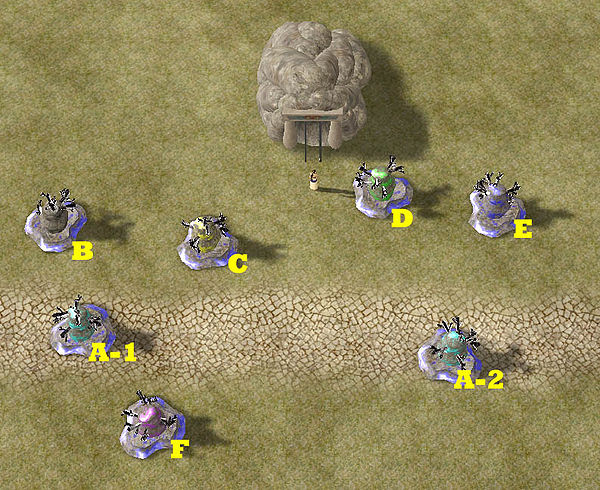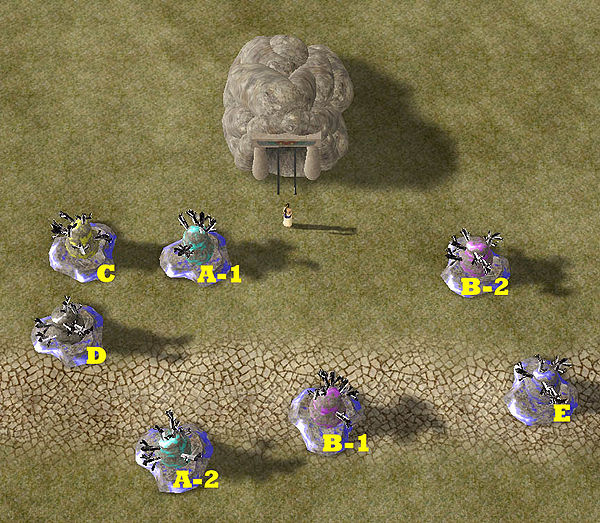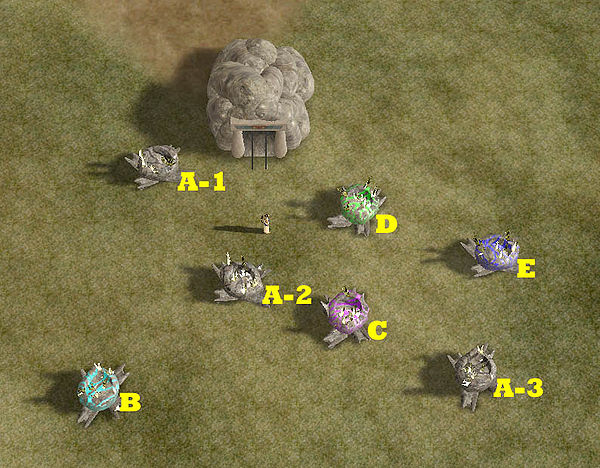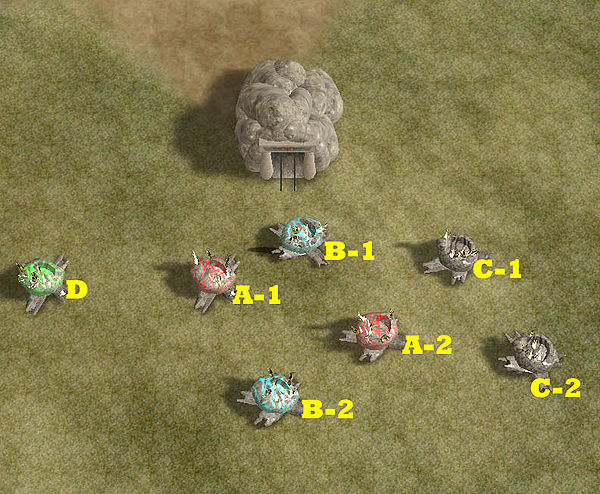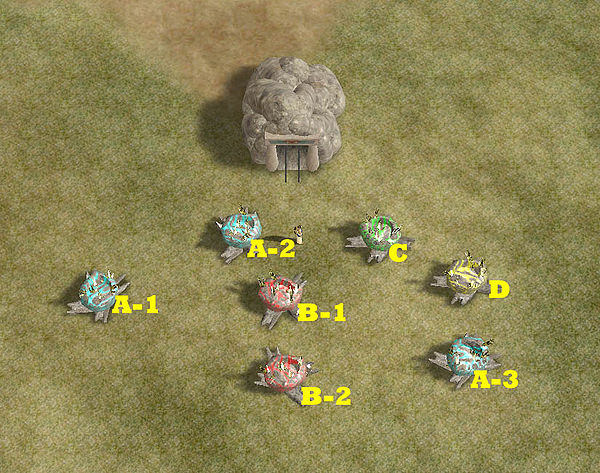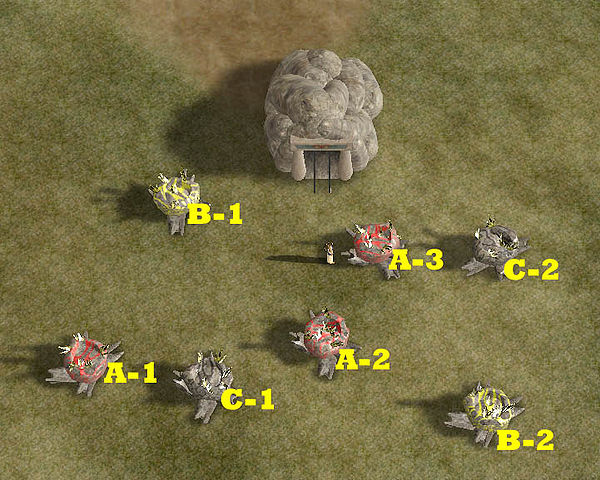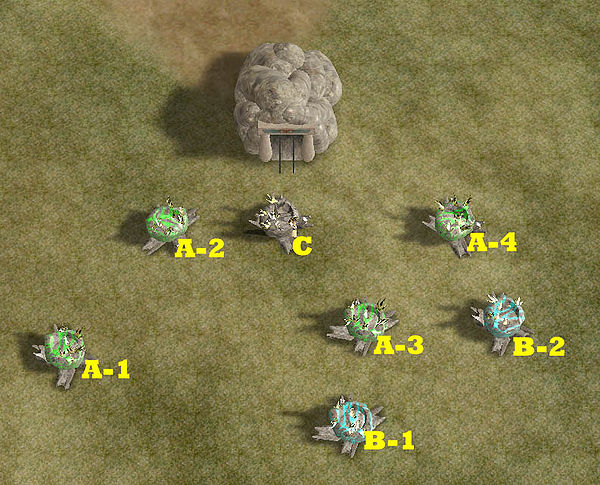The Wiki for Tale 6 is in read-only mode and is available for archival and reference purposes only. Please visit the current Tale 11 Wiki in the meantime.
If you have any issues with this Wiki, please post in #wiki-editing on Discord or contact Brad in-game.
Difference between revisions of "Guides/Mining/Sand Mining"
| Line 27: | Line 27: | ||
# A, B, C, D, E, F, G ''Breaks all 7 stones'' | # A, B, C, D, E, F, G ''Breaks all 7 stones'' | ||
|} | |} | ||
| + | |||
| + | |||
== Six Colors (One Pair) == | == Six Colors (One Pair) == | ||
| Line 53: | Line 55: | ||
# A-2, C, D, F ''This workload will crumble the remaining stones'' | # A-2, C, D, F ''This workload will crumble the remaining stones'' | ||
|} | |} | ||
| + | |||
| + | |||
=== Six Colors (Alternate) === | === Six Colors (Alternate) === | ||
| Line 77: | Line 81: | ||
# A-2, B, C, D, E, F ''Breaks the remaining 6'' | # A-2, B, C, D, E, F ''Breaks the remaining 6'' | ||
|} | |} | ||
| + | |||
| + | |||
== Five Colors (Two Pairs) == | == Five Colors (Two Pairs) == | ||
| Line 103: | Line 109: | ||
# A-2, B-2, C, D, E ''Breaks the remaining 5 stones'' | # A-2, B-2, C, D, E ''Breaks the remaining 5 stones'' | ||
|} | |} | ||
| + | |||
=== Five Colors - Alternate Method === | === Five Colors - Alternate Method === | ||
| Line 130: | Line 137: | ||
The same process can be applied to 6- and 7-color fields. Make 6 sets of complementary pairs of workloads, and then one big one to break them all. | The same process can be applied to 6- and 7-color fields. Make 6 sets of complementary pairs of workloads, and then one big one to break them all. | ||
| + | |||
| + | |||
== Five Colors - (Triple) == | == Five Colors - (Triple) == | ||
| Line 160: | Line 169: | ||
# A-3, B, C, D, E ''Breaks B, C, D, and E'' | # A-3, B, C, D, E ''Breaks B, C, D, and E'' | ||
|} | |} | ||
| + | |||
| + | |||
== Four Colors (Three Pairs) == | == Four Colors (Three Pairs) == | ||
| Line 185: | Line 196: | ||
# A-1, B-1, C-2, D ''This will break all 4 stones'' | # A-1, B-1, C-2, D ''This will break all 4 stones'' | ||
|} | |} | ||
| + | |||
| + | |||
=== Four Colors (Three Pairs) - Replacement Proposal === | === Four Colors (Three Pairs) - Replacement Proposal === | ||
| Line 209: | Line 222: | ||
# A-1, B-2, C-2 ''This will break remaining 3 stones'' | # A-1, B-2, C-2 ''This will break remaining 3 stones'' | ||
|} | |} | ||
| + | |||
| + | |||
| + | |||
== Four Colors (Triple and Pair) == | == Four Colors (Triple and Pair) == | ||
| Line 234: | Line 250: | ||
|} | |} | ||
| + | |||
| + | |||
== Four Colors (Quadruple) == | == Four Colors (Quadruple) == | ||
| Line 260: | Line 278: | ||
# A-1, A-2, A-3, A-4 ''Breaks A-1, A-2, A-3'' | # A-1, A-2, A-3, A-4 ''Breaks A-1, A-2, A-3'' | ||
|} | |} | ||
| + | |||
| + | |||
== Three Colors (Triple and Two Pairs) == | == Three Colors (Triple and Two Pairs) == | ||
| Line 272: | Line 292: | ||
None. | None. | ||
|} | |} | ||
| + | |||
| + | |||
== Three Colors (Quadruple and Pair) == | == Three Colors (Quadruple and Pair) == | ||
| Line 291: | Line 313: | ||
|} | |} | ||
| + | |||
| + | |||
== Three Colors (Quintuple) == | == Three Colors (Quintuple) == | ||
Revision as of 05:59, 13 November 2010
Overview
Gems (and coal) are acquired when ore stones in a mine are broken (by being used in 7 workloads). The size of the gem is random. There is some evidence to suggest that when more ore stones are broken in the same set and/or workload, the gem sizes on average tend to be larger; however, it's still perfectly possible to pull a Huge gem without exploiting this. Sand mines are thus valuable for gem mining, as it's easy to plan in such a way as to break 5+ nodes at once (assuming there are 5 different colors present in the field).
Below are some step-by-step guides for how to get the most gems per workload for various workload configurations.
For the basic mechanics of mining, please refer to the Mining Guide.
Workload Configurations
Seven Colours
For a workload distribution of seven single colors, all stones can be crumbled all at once:
|
Sets
|
Six Colors (One Pair)
For a workload distribution of 5 single colors, and then 1 pairs of colors, you can achieve the crumbling of all seven ore stones by following the pattern as laid out below:
|
Sets
|
Six Colors (Alternate)
It is also possible to form a group of 6 that breaks all at once, if desired.
|
Sets
|
Five Colors (Two Pairs)
For a workload distribution of 3 single colors, and then 2 pairs of colors, you can achieve the crumbling of all seven ore stones by following the pattern as laid out below:
|
Sets
|
Five Colors - Alternate Method
Using the theory that gem size is tied to the number of stones broken in a single workload (as opposed to the number of total stones broken in a field), the above can be simplified to do a little less work and still get the big break that will be producing most of the big gems.
Refer to the above image.
First, choose one of the duplicate-colored stones to ignore completely. Here we'll choose B-2. Then pick one of the stones in the remaining pair (say, A-1) to be your starter stone. Make any valid 3-stone workload starting with your starter stone, and immediately follow that with the workload consisting of the remaining 3 stones. There are exactly 6 sets of these pairs of workloads. Do them all.
| A-1, C, D | A-2, B-1, E |
| A-1, C, B-1 | A-2, D, E |
| A-1, C, E | A-2, D, B-1 |
| A-1, D, B-1 | A-2, C, E |
| A-1, D, E | A-2, C, B-1 |
| A-1, B-1, E | A-2, C, D |
And finally choose a 5-stone workload (either A-1 or A-2 in addition to B-1, C, D, and E).
The same process can be applied to 6- and 7-color fields. Make 6 sets of complementary pairs of workloads, and then one big one to break them all.
Five Colors - (Triple)
A triple and five single colours allows us to break 5 stones, which can be done all at once.
|
Sets
Alternatively, you can replace the last step with these two steps, for more broken stones but fewer at the same time:
|
Four Colors (Three Pairs)
With three pairs of colours all stones can be broken, in a group of 3 and a group of 4.
|
Sets
|
Four Colors (Three Pairs) - Replacement Proposal
The above pattern does not work for me. The 14 sets always leaves 3 stones remaining. Working the remaining 3 stones (a 15th set), will break the last 3 stones. I propose below be the new standard for 4 color (3 Pair). But leaving original alone, above, in case someone wants to verify or can see something I am missing. ~ Cegaiel
|
Sets
|
Four Colors (Triple and Pair)
With a triple and a pair of colours it is possible to break 4 stones, which can be done all at once.
|
Sets
|
Four Colors (Quadruple)
With a quadruple of a colour it is possible to break 6 stones, in two groups of 3.
|
Sets
|
Three Colors (Triple and Two Pairs)
When we have a triple and two pairs of colours, no stone can be worked seven times. Just do a few workloads to speed up resetting the mine.
|
Sets None. |
Three Colors (Quadruple and Pair)
When there is a quadruple and a pair of colours, only the single stone can be broken.
|
Sets
|
Three Colors (Quintuple)
When there is a quintuple, five stones can be broken.
|
Sets
|
